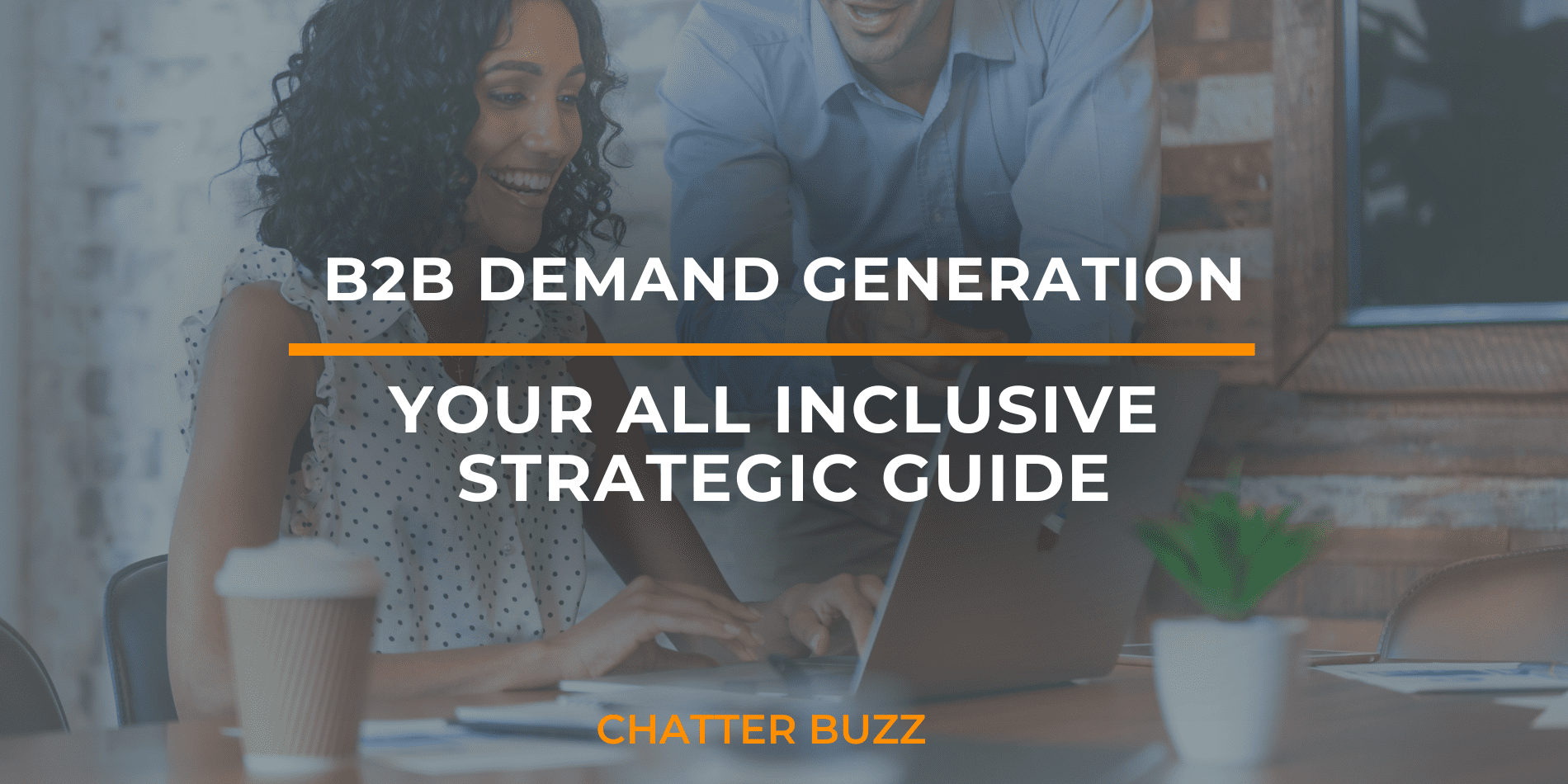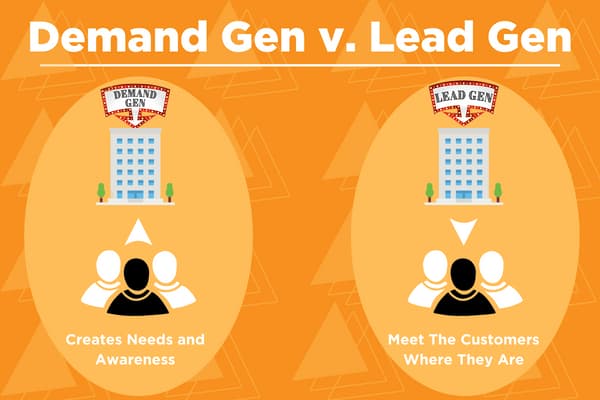B2B Demand Generation: Your All-Inclusive Strategic Guide

In the ever-evolving world of B2B marketing, B2B demand generation has emerged as a unique way to propel a business’s offer to the forefront of the client’s mind. But, how?
It’s pretty simple, actually…
B2B demand generation is a marketing technique that creates “demand” for your product or service BEFORE the client actually needs it. The idea is to prime the client towards your brand in such a way that they will automatically choose to do business with you the minute they actually need your product or service.
Similar to how lead generation seeks to pull in qualified leads, demand generation aims to cultivate genuine demand! Pretty cool, huh?
So, how can your business apply B2B demand generation to its marketing campaigns?
In this guide, we will delve into the ins-and-outs of B2B demand generation, including:
- What is B2B demand generation?
- Lead generation vs demand generation
- Why should you employ a B2B demand generation strategy?
- 7 steps to a successful B2B demand generation strategy
- How to optimize your strategy for long-term growth
Ready to take your client’s growth potential to new heights? Let’s get started!
What Is B2B Demand Generation?
In essence, B2B demand generation is exactly what it sounds like: A method for businesses to attract demand from other businesses to purchase their products or services.
But it’s so much more than that.
This process is focused on the goal of driving awareness and interest in your organization’s goods or services. From there, the new ideal clients, or leads, learn about your product and desire to become your customers.
You may think this is a different way of saying lead generation, but it’s not. Keep reading to learn the key differences between lead generation vs demand generation.
Differences Between Lead Generation and Demand Generation
Although lead generation and demand generation can work together to achieve a common goal, they are 2 very distinct strategies.
For starters, lead generation targets specific subsets of the market. It focuses on stimulating and holding the interest of potential customers that will eventually get shuffled into a sales pipeline. While lead generation is more targeted and will see a quicker return on investment, the sales cycle is short-lived.

On the other hand, demand generation focuses on long-term engagement with ideal customer profiles, or ICPs. Contrary to lead generation, B2B demand generation uses a much longer, personalized, and intricate sales funnel.
Although you should be aware that it will take time to see the results of B2B Demand Generation, you must know that your patience will pay off… in BIG ways $$$! After all, growing your B2B business is more akin to a marathon, not a sprint.
Why Should You Employ a B2B Demand Generation Strategy?
You might be thinking to yourself, “My company is doing alright, should I still consider a B2B demand generation strategy?”
Yes. Whether your business is already strong or not, a B2B demand generation strategy can help you grow even stronger! Here’s why.
A successful B2B demand generation strategy sets companies up for success and pushes them far above the competition. Instead of slowly trudging towards your business growth goals, B2B demand generation may help you reach higher quality clients and achieve a lofty ROI faster.
If you are looking for the benefits of strategic B2B Demand Generation, here are to name just a few:
Benefit #1: B2B Demand Generation Targets High-Quality Clients
As a B2B enterprise, your biggest goal is to land the crème de la crème of clients. You don’t want to waste your time with small fish that won’t actually convert. You want to hook the high-value clients that will partner with you for years to come!
By employing targeted campaigns across various channels such as social media, content marketing, email, and events, you can attract prospects who are genuinely interested in your offerings.
This also ensures your sales team won’t waste time chasing leads that are unlikely to convert. Instead, you put all of your energy towards solid leads, which yields higher conversion rates and improved ROI.
We’ll explain how to target high-quality clients later on!
Benefit #2: B2B Demand Generation Increases Brand Credibility
Once you acquire high-quality leads, you’ll engage with larger and more reputable companies. This association inherently enhances your brand’s credibility.
Credibility stems from various sources, but active customers serve as a primary indicator. Just as consumers often seek out products with top ratings, businesses similarly evaluate potential partners based on their track record.
In addition to lead acquisition, B2B demand generation strategies encompass various tactics aimed at bolstering brand credibility:
- Create compelling case studies
- Provide free educational content
- Maintain consistent brand messaging that meets the needs of the client
- Emphasize transparency and best industry practices
These initiatives, along with effective messaging strategies, position your company as a thought leader within the industry. And as you know, this is a HUGE deal when it comes to brand credibility… not to mention thought leaders naturally increase SEO rank as well. Talk about a win-win.
/f/84825/480x400/20bb610d48/ea67ef2f-fa66-42a2-93e2-11a53ba59512.gif)
When other businesses recognize your brand as a leading authority, it confirms that your company is operating at its highest level of performance.
Moreover, B2B demand generation plays a crucial role in building brand equity and credibility within B2B space. Through consistent and value-driven communication, companies can position themselves as trusted advisors in their respective industries.
This not only helps attract new customers, but it also retains existing ones since businesses are more likely to partner with companies they perceive as reliable and knowledgeable.
Benefit #3: B2B Demand Generation Fosters Long-Term B2B Partnerships
Lastly, demand generation fosters long-term relationships with clients through tailored lead nurture campaigns such as a skillfully targeted and highly valuable email sequence.
Why nurture campaigns?
Lead nurture campaigns seek to deliver relevant and personalized content at each stage of the buying process. Yes, you guessed it – it all boils down to your sales funnel!
This allows businesses to engage with prospects on a deeper level, addressing their pain points and providing solutions. This results in increased:
- Increased customer satisfaction
- Strengthened loyalty
- Stronger brand advocacy
- Repeated business
- Organic referrals
In a competitive landscape where customer acquisition costs are rising, investing in B2B demand generation is not just a strategic choice but a NECESSITY for driving success and staying ahead of the curve.
Before we get into how to create the best B2B demand generation strategy for your business, let’s take a quick look at market dynamics.
Market Dynamics for B2B Demand Generation
Here’s a simple marketing truth: You MUST understand your industry’s market dynamics if you want your business to adapt and respond to the ever-changing needs of your clientele. The same is true for B2B demand generation marketing.
So, what exactly do we mean by market dynamics?
Simply put, market dynamics refer to the forces that influence behavior and shape the overall demand for products or services. These forces can include factors like:
- Economic conditions
- Technological advancements
- Competitive landscape
- Social trends
By analyzing market dynamics, you can gain valuable insights into your target audience’s preferences and pain points. This knowledge enables you to tailor your marketing efforts towards meeting these specific needs effectively.
7 Powerful Steps to a Successful B2B Demand Generation Strategy
Ready to learn how to create a B2B demand generation strategy for your business? Here are 7 valuable steps to get you started!
1. Identify Your Target Audience for Maximum Impact

As promised, let’s talk about how to attract those high-quality clients to your brand.
Identifying and targeting the right audience is crucial in B2B demand generation strategies. Without this, you are essentially shouting into a void, hoping someone responds. You need a target.
To effectively reach and engage potential customers, businesses need to clearly understand who their target audience is and what motivates them. You can do this in 3 ways:
- Conduct thorough market research
- Analyze consumer behavior
- Identify key demographics
Once businesses have a clear understanding of their target audience, they can tailor their marketing messages and campaigns to resonate with these specific groups.
By speaking directly to the needs, interests, and pain points of their target audience, businesses will create a deeper connection with their target audience. This will ultimately increase the chances of conversion.
2. Direct Your Marketing Energy to the Right Place
Instead of wasting time and money on broad marketing efforts that may not yield results, companies should focus their efforts on reaching those companies who are most likely to be interested in their products or services.
Imagine being able to save your team the headache of endless budget adjustments simply because you did your due diligence at the beginning! This targeted approach ensures that every dollar spent on marketing has a higher chance of generating a positive return on investment.
Where Is Your Audience Located?
If your ideal clients only use LinkedIn and Google, why waste any effort with Facebook Ads? If your consumer behavior reports indicate that the best time to contact them is between 1-4PM, why would you bother sending an email first thing in the morning?
These are questions you must ask yourself from the beginning! Don’t waste your time and money on marketing efforts that will miss the mark.
Here’s the simple truth: Businesses enhance the effectiveness of their demand generation endeavors when they target the right audience and employ the right marketing tactics from the get-go.
Now, let’s talk about how you should target your audience through engaging, valuable, and personalized content.
3. Craft Compelling Content

In this step, we’re going to tell you about B2B demand generation content. Keep in mind, this varies slightly from your traditional lead generation content. The goal of demand-oriented content is to foster… well… DEMAND!
How to Create Demand-Driven Messaging
Now that you have defined your audience, it’s time to create content that will hook them at first sight.
Your content is extremely important in the realm of B2B demand generation and business growth. In order to capture the attention of another business, businesses must create messaging that speaks directly to their audience’s needs.
Route Out Client Pain Points
A business’s product or service should solve a problem; make something easier, faster, more organized or technologically updated. What the problem it solves needs to be the focus of the campaign.
It’s like the infomercials that start with questions:
- Are you tired of…
- Sick of…
- Need help with…
These emphasize the pain points that the product will solve. If the pain point is known, the marketing can be made more relatable and memorable for its target audience.

Here’s where this step differs from traditional lead generation…
The secret to demand generation is to CREATE DEMAND. Sometimes, you might need to define a problem that your client might not even know they have. Once you develop the problem and present it to them, they’ll begin to desire a solution to that problem.
And guess what? Your brand will be the answer to that pain point! Demand generation requires you to think outside of the box and position yourself as a unique and different solution to perceived problems.
Position the Client as the Hero
At its core, everyone wants to be the hero of the story. So why not fulfill that here?
When marketing to your target audience, you should always make them the focal point of your message… NOT your company. When done properly, you will evoke an emotional response within them. It’s a response they will hold on to and remember for days after seeing your content.
The creative content should put the audience at the centerpiece of its marketing. It will show that the company is there to help guide them to a solution. When that feeling is evoked, your target audience is more likely to convert.
Highlight a Unique Value Proposition
While the other two points are important, there will always be the one question that is asked:
“What makes you different?”
This goes back to the pain points earlier. What can make you different is if you perform a necessary task faster, better, more efficiently. It can even be a value or mission for the company as a whole. Does your company strive to make change in an industry or provide better services?
This question needs to be answered clearly and concisely. Setting one business apart from the others will always be a deciding factor for people and it usually has nothing to do with price.
4. Reach Clients through Various Channels
Digital marketing channels can be leveraged to maximize reach and engagement for businesses in today’s highly competitive market. With the rapid advancement of technology and increasing dependence on online platforms, businesses must adapt their marketing strategies to effectively reach their target audience.
Digital marketing channels such as:
- Social Media
- Search Engine Optimization (SEO)
- Email Marketing
- Content Marketing
- Paid Advertising
These provide numerous opportunities to connect. These channels allow businesses to create engaging and personalized content that resonates with their target audience while also providing a platform for interaction and feedback.
How to Maximize Reach through Digital Marketing Channels
Businesses shouldn’t only increase brand visibility, but they should also build meaningful relationships with these potential partners. Through targeted advertisements or compelling social media campaigns, companies can drive traffic to their website or other digital platforms where they can further engage users through informative content or attractive offers.
Here’s an example.
A few years ago, Owlet Baby Care ran a campaign for their new monitor. During their research, they found that 81% of mothers were using Facebook over other channels. They then used a creative with pastel accent colors against a night sky background, animated illustrations, smooth scrolling motion and product highlights accompanied by a “Shop Now” button.
This increased their CTR by 55% and order values increased by 19%.
To master the art of demand generation, you must utilize various digital marketing channels effectively. When you incorporate these tactics into your overall demand generation strategy, it will enable you to stay ahead of the competition and build strong connections with your customer base.
5. Generate & Nurture High-Quality Leads
Next, the ability to generate and nurture leads is an essential for business growth. To effectively generate leads, it is important to conduct market research to gain insights into consumer preferences, behaviors, and needs.
Diversify Your Social Platforms

Facebook, Instagram, LinkedIn, Pinterest, Reddit, Snapchat, and even TikTok are all powerful tools for lead generation.
With millions of users who scroll, click, like, and interact daily, these platforms offer vast opportunities to capture attention. As mentioned earlier, your responsibility is to ensure that the content they engage with is sourced from your business’s content page.
At the heart of this strategy lies the creation of quality, relatable content and the promotion of awareness across channels where your target audience is most active. You can effectively reach and engage potential leads, ultimately driving business growth through the proper leverage of these channels.
Invest in Marketing Automations
Everyone has been enrolled in automations by a company. Texts about the latest perks, reminders about upcoming events, and emails about flash sales are just a few of the goals for different types of automations.
Marketing automation can be created through many different platforms and all that is needed from your potential client as a phone number or email address. These messages are created and dispersed so a business can add touch points with their lead.
On average, a client needs 5 touch points before they convert. Although a simple online impression may work from time to time, direct outreach is more likely to yield stronger results.
6. Analyze the Results of Your Campaigns
The target audience has been identified, the content has been created, and it’s going out to all of these new potential clients for the business. Now what?
As former marketing great Peter Druker said, “What gets measured, gets managed.” So it’s time to measure.
How to Measure the Success of Your B2B Demand Generation Campaign
Once the campaign is outlined, businesses need to know what metrics will determine if the campaign worked. They also need to set up check-ins so they can know if the campaign is not working, they can shift without losing too much time.
The measurement of success will depend on different factors depending on the industry a business is operating in. What key performance indicators will determine success over failure?
Here are just a few KPIs that many companies have used to measure their success:
- Cost Per Click
- Total Leads
- Total Conversions
- Cost Per Lead
- Appointments Booked
These are just a few different KPIs that should be tracked over the life of the campaign. Businesses can compare month-to-month or even year-to-year with the right metrics and set up through a CRM or marketing platform.
7. Optimize Your Strategy for Long-Term Growth
The B2B demand generation strategy is NOT a “set it and forget it” venture. It must be optimized for the long-term. The goal of B2B demand generation is to source leads over the long-term verse in short bursts.
Here are some of the best ways to ensure your strategy stays sound:
Establish Clear Goals
Setting goals is the key to success. There are even acronyms to help set goals like S.M.A.R.T. (Specific, Measurable, Achievable, Relevant, Time-Based).
A clear goal will provide a solid foundation for a company that is just starting out with B2B demand generation. It keeps the goals in a frame that can be made easily understandable for everyone involved.
Goals should also be set further out. Once one goal is reached, another goal should be there like a weightlifter. Lifting 225 lbs is great, but once you lift it, it’s time to go higher!

Use Data Analytics
Businesses gain valuable understanding from both past experiences and customer behaviors, enabling them to refine their strategies and leverage data-driven insights. With this, businesses can further optimize their efforts through predictive analytics and personalized targeting to maximize the impact of their campaigns.
With a focus on data analytics, businesses can unlock invaluable insights that inform every aspect of their lead generation process.
When your team analyzes historical data and monitors ongoing customer interactions, you will identify patterns, preferences, and new pain points, which will allow you to continue using a tailored approach that truly resonates with your target audience.
Test Different Channels
Marketing is always evolving. A tactic that may work today might become obsolete by next year due to technological advancements, new software updates, and social pressures. That is why it is best to test different channels.
It’s important to stay up to date on these changes to better equip yourself for future marketing shifts. For example, no one was ready when Elon Musk bought Twitter and rebranded to X. Partners and advertisers pulled their funding almost immediately. Who’s to say something similar won’t happen to Facebook or HubSpot?
Testing different channels can also position your company as an early adopter of new technology. If businesses want to continue to be thought leaders, this is an excellent step to take.
Final Thoughts
At the end of the day, effective B2B demand generation is not just a strategy; it’s a journey that requires adaptability, innovation, and a deep understanding of your target audience.
At Chatter Buzz, we recognize the importance of staying ahead of the curve. Our approach to lead generation integrates cutting-edge techniques, data-driven insights, and our years of expertise to help businesses thrive in today’s competitive environment.
Whether you’re looking to expand your client base, increase brand awareness, or drive conversions, Chatter Buzz is here to guide you every step of the way.
Let’s embark on this journey together and unlock the full potential of your business. Contact us today to get a FREE strategy session and learn how we can elevate your B2B demand generation efforts to propel your company to new heights.
Do you need someone to help you achieve your growth goals - then let us help you crush them? Let's chat!
Error: Contact form not found.








